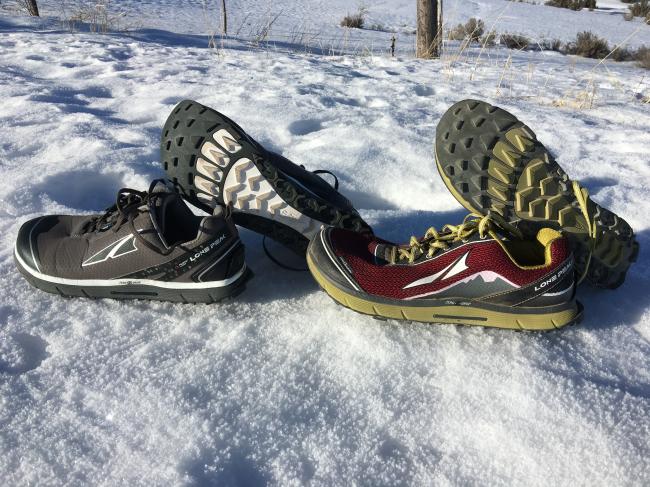
Altra Lone Peak Neoshell on left and Altra Lone Peak 2.5 on right
Altra is unarguably one of the brands on a very quick rise in the running world these days, especially in the trail and ultra market. I’ve had a long history with the Lone Peak, picking up a pair of the original Lone Peaks pretty much right at release. I ran a couple of ultras in them, but ultimately I ended up drifting away from them, only just recently coming back to trying the Lone Peak 2.5 and Neoshell (Disclosure: Altra was kind enough to send both shoes free of charge for review purposes).
Traditionally, the problem I’ve had with Altra is that while I love the wide toebox, the midfoot and heel are just far too roomy to hold my foot adequately. The Superior 2.0 is the first of their shoes where I don’t have this problem (although the heel is still wider and more padded than necessary). The Lone Peak 2.5 and Neoshell are the best fitting Lone Peaks yet, and show some solid improvement. Below I detail some of those improvements, as well as areas where the shoes can continue to get better.
Specs
Lone Peak 2.5 – weight: 10.1 oz (286 g) mens 9; 9.1 oz (257 g) womens 8, stack height: 20mm forefoot and heel, price: $120
Lone Peak Neoshell – weight: 11.4 oz (323 g) mens 9; 9.6 oz (272 g) womens 8, stack height: 20mm forefoot and heel, price: $150
Specs via Running Warehouse.
Upper and Fit
While fit is one of the bigger problems I’ve had with Altra shoes in the past, the good news is that the Lone Peak 2.5 and Neoshell are both better than past Lone Peaks in providing a more secured fit. I initially thought that the 2.5 was near perfect fit-wise, but unfortunately after taking them out for a couple runs the upper material stretched to the point where I couldn’t tighten them anymore (I think this is due to the fact that there are no overlays to speak of on the shoe, thus no structural support for the upper). This was especially noticeable on a trip down Grandeur Peak in Salt Lake City while I was attending Outdoor Retailer this past summer. The Neoshell doesn’t have this problem – even though it also has no overlays, the Neoshell material itself does not stretch and acts as one large overlay. So, despite having the Lone Peak 2.0 fit (which has more volume than the 2.5), the Neoshell actually held my foot better and is by far my favorite Lone Peak to date.
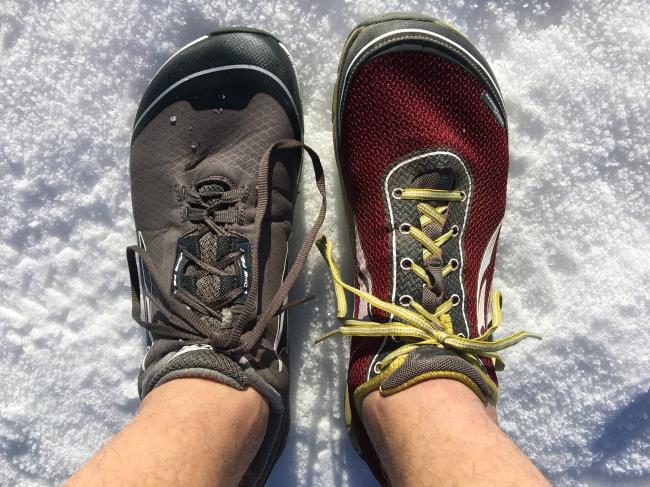
Difference in fit. 2.5 upper is soft and comfortable, but it stretches even more when running due to no overlays, and as you can see I don’t have much cinching left that I can do.
The great news is that Altra is completely revamping the entire Lone Peak line, and added overlays on the uppers and a new outsole for summer 2016 with a Lone Peak 3.0 and Neoshell 3.0, along with a mid cut Lone Peak Neoshell which looks awesome for long winter outings. Sam Winebaum has a great writeup from The Running Event that details the new Lone Peak lineup.
In the end, the Neoshell 2.0 has a comfortable fit that, especially due to the wide forefoot, is very warm in winter. I think that the Neoshell material, which is put on the outside of the shoe rather than in an inner waterproof bootie, is going to set a new industry standard. I’ve hardly ever liked shoes with GTX because of the bootie seams, particularly in the heel, and they almost always have the same upper as the regular version just with the added bootie. This allows that outer upper material to get wet and heavy, yet it doesn’t really serve a ton of purpose. The Neoshell material and design simplifies the upper, doesn’t absorb water and the interior of the upper has no added seams. It’s one of those, “duh, why haven’t companies done this sooner”, type of design shifts.
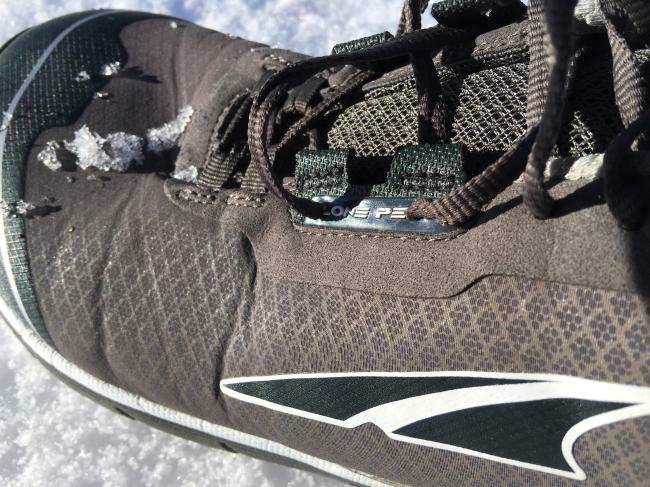
The Polartech Neoshell material is fantastic and really makes the shoe. Notice I did punch holes in the the Lone Peak tab to be able to cinch the shoe a little better in the midfoot. I’ll probably cut the loops off too.
Midsole and Ride
The Lone Peak is in an interesting spot for me ride-wise. The protection that they give is fairly moderate, they’re not super heavy, and they have quite a bit of cushion. On paper and on initial runs they felt like a great all-around package, but after a few more runs I started to notice a very apparent lack of sharpness on most uneven terrain, and while cushioned, they just aren’t at all responsive. I think this is partly due to the midsole material being fairly average in terms of rebound (the softer midsole on the Neoshell actually feels better in this regard), but also because of the geometry of the midsole and some constraints brought on by Altra’s zero drop design philosophy. While not as bad as the Olympus, the one problem zero drop creates on shoes with more stack height (which BTW, even though zero drop is natural, high stack height is not) is that you can’t have a gradual toe spring/taper because of the need for the shoe to be absolutely zero drop through the ball of the foot. When you have to go from 20mm of stack or higher to some sort of taper to the end of the shoe all from the ball forward, it creates a delayed toe off that, while not a big deal at slower speeds, is really noticeable to me below 8 min/mile pace or faster, which makes the shoe feel like it won’t turn over very quickly and just lands flat.
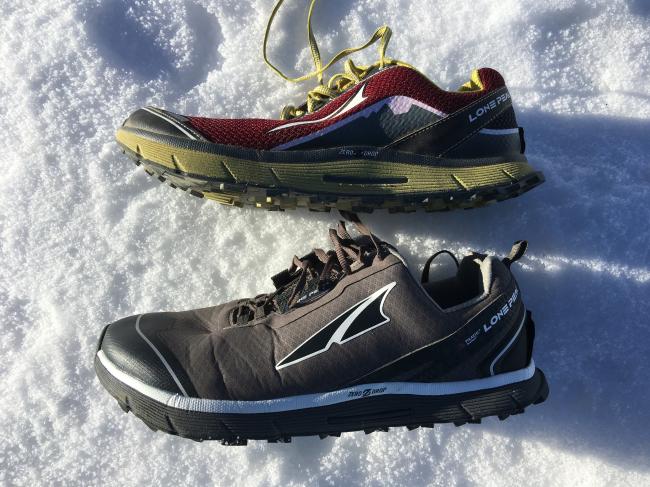
Same midsole design on both. Neoshell has a little softer midsole like the 2.0 did, which surprisingly felt better to me than the 2.5.
Additionally, while some of Altra’s design philosophy is industry leading and a huge asset (like the wide toebox and Neoshell construction), their rock plate design is not my favorite. They sandwich the rock plate between the midsole and strobel to, as they say, add some ability for the midsole to deflect the rock before it hits the rock plate instead of hitting a rock and causing the shoe to pivot as they claim a traditional rock plate construction that puts the plate between outsole and midsole does. In reality, I’ve found the opposite to be true. The only time the Lone Peak (or Superior) rock plate design works as advertised is for very small gravel, which the shoe absorbs and it thus doesn’t tip or pivot much.
However, when you get on technical terrain with anything larger than a marble sized rock, I find the Altra rock plate design actually makes the shoe more unstable and less protective. You can’t feel the rock on initial contact, but as the midsole compresses, it hits the rock plate and then pivots in a more delayed nature which is way worse to me than just feeling the rock on initial contact and relying on your proprioception of the ground and foot/ankle strength to stay balanced. Additionally, the Lone Peak rock plate design doesn’t protect the midsole from the abuse of rocks like a traditional design does, and therefore th midsole deteriorates quicker than it would with a traditional rock plate. I’m contemplating a future post on rock plates to highlight some of the designs that work best in my experience, but this is one area where I hope Altra reconsiders their alternative approach, and it is even more relevant with the Superior which has exposed midsole on the bottom of the shoe.
Outsole
The Lone Peak 2.5 and Neoshell have the same exact outsole design. While in general the outsole works well as an all purpose outsole, and isn’t too luggy for dry terrain, nor lacking grip in looser terrain, I also found a few things that could use some tweaking. First, I think, like the Nike Kiger 3 the lugs are too deep for the stack height of the shoe, which only adds weight and decreases the responsiveness of the ride. The shoe isn’t light or precise enough to really take advantage of the lugs, and especially with the Lone Peak 2.5 upper, doesn’t hold the foot securely enough on technical terrain either. For the Neoshell, I actually think the lug design is just fine since I end up using that shoe mostly on snow and mud anyway, and not on dry trail that often.
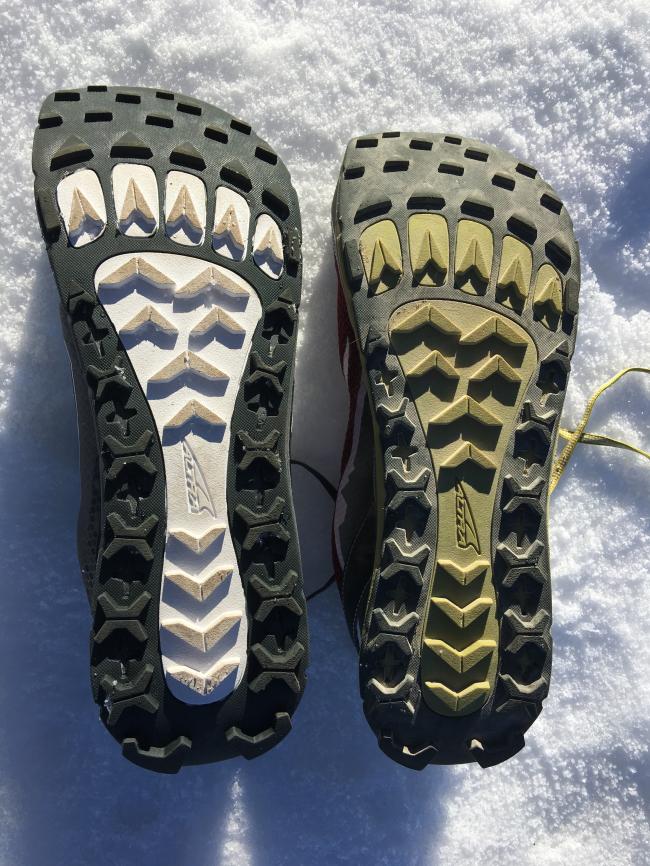
Lots of rubber on this outsole, and I think probably too much and too deep for how the shoe handles technical terrain. The lugs on both edges from the midfoot back are oriented far too much for breaking and would be better being directional till the last couple lugs.
The other issue with the design is that the lugs on the lateral midfoot are oriented to break and I don’t find this to be very enjoyable on drier trail, especially on downhills. A little bit of float is really helpful on downhills, and I don’t think there need to be any lugs oriented for breaking traction until the heel, and even then the center and medial heel is enough (more like the Salming T1). If we are talking about an all out mountain/off trail shoe, then I think lug design is a different story, but for any trail shoe that is designed more as an all around, varied terrain shoe, then the lugs need to be shallower and oriented so they don’t break too much on hardpack. The new Lone Peak 3.0 outsole looks to address a few of these issues with multidirectional lugs in the middle of the outsole (a great change) and less aggressive lugs on the midfoot, although they are still oriented horizontally (would be better flipped on their side in the direction of the travel of the foot; which would also decrease the shearing effect on the lugs).
Conclusion
Overall, I am a big fan of what Altra is trying to do, and that is why I even went to the effort to detail the issues with certain design elements, and the reason for the longer review. I think there is a lot to like in their shoes, and I want to see them continue to improve. The Lone Peak has such potential to be the perfect ultramarthon/long run shoe with their wide toebox, medium stack, and versatile outsole, but it needs some tweaking for me to start a race with them on my feet. The Neoshell is by far my favorite out of any Lone Peak I’ve tried, and is a very nice addition to my winter shoe quiver with the wide fit and fantastic Neoshell upper design. Unfortunately, for any temps hotter than 30 deg F, I can’t see using them just because of how warm they run (which is a major asset in winter). I’ve been dreaming of doing the Iditarod Trail Invitational (350 winter race in Alaska) someday, and am always evaluating a winter shoe with that in mind; the forthcoming Lone Peak 3.0 Neoshell Mid looks really good for a race like that or long winter outings in general.
In the end, I can definitely recommend the Lone Peak Neoshell 2.0 as a winter shoe. The design that puts the waterproof material on the outside is nothing short of revolutionary for waterproof shoe construction, and the shoe just runs and feels better for me. The Lone Peak 2.5, on the other hand, just doesn’t come together in a well enough executed package for what I feel the intended use of the shoe (all around trail) is meant to be. For flatter terrain, it’s fine and the fit will be nice and comfortable, but, for me, the lack of upper security, unstable midsole/rockplate design, and outsole design issues take too much away from the experience. I feel there are better shoes in the same weight/protection category like the adidas Response TR Boost, Nike Wildhorse 3 and Pearl Izumi N2v2 that run better, are more secure and are more stable. Needless to say, I’m still super excited to see where Altra continues to go with their shoes, and also eager to see how the Lone Peak 3.0 lineup can improve the Lone Peak experience.
The Altra Lone Peak 2.5 and Neoshell are available for purchase at Running Warehouse.



















Waterproofing on the outside layer is not new. Outdry does this and has been around for years. Geoff Roes ran the ITI in Montrail Mountain Masochists Outdrys.
Not entirely true. I have some Bajada II outdrys and they fuse the two layers but the outer layer is still the same mesh as the regular model (so absorbs water and adds stiffness/weight) and they still have the seam in the heel the same as a GTX shoe. Not saying they don’t work (as Geoff shoed at ITI) but the Neoshell doesn’t have either of these features and is just one layer of material (where Outdry is two). It is much cleaner and simpler that I think it is actually notable and new. -David
I don’t know what you mean.
http://polartec.com/product/polartec-neoshell
Polartec’s site shows that Neoshell is layer that is laminated to the underside of a face fabric. That is what Outdry is too, though with a different film layer with different properties.
What makes this “outside”, like Outdry and as opposed to many older systems, is that the waterproof layer is not is on a completely separate booty layer that is effectively like a sewn in Goretex or other branded sock.
Outdry claims that the heat sealing leaves no seams or gaps. I don’t see any claims on the Neoshell or Altra websites that say that there are no seams. I think there must be one. After all, the upper on the Lone peak, even if the main part is one piece, probably has a seam up the back unless it were knit into one piece, which is isn’t. A Goretex shoe’s seams will be completely waterproof too, at least when new. Maybe the difference that you are noticing is the coarseness of the face material in the Montrails vs the finer material on the Altra Neoshells.
It sounds to me like the Altra Neoshell is using the same approach as Outdry, except using their fancy laminate material, which may be a better performer.
I think we’ll have to respectfully disagree. I have the Bajada II Outdry and Altra Neoshell right in front of me as I type this and they are definitely not constructed the same way with the Bajada clearly having two distinct layers, even if “fused” together the outer layer is the exact same mesh and overlays as the regular Bajada II; the Lone Peak Neoshell on the other hand is constructed just like a normal shoe is with just one upper layer that happens to be waterproof (like as if the Outdry or GTX membrane also acted as the outer face material), where in the Bajada Outdry, it is a second material that lines the regular outer mesh. This video: https://www.youtube.com/watch?v=w6z-dHE7tMU of the forthcoming Lone Peak 3.0 series, including new Neoshell models has Altra speaking more to this and they clearly state it is waterproofing on the outside and this is exactly what I see with the Lone Peak 2.0 Neoshell and it is distinctly different than the Outdry product.
David, thanks for this review. The last time I tried the Lone Peak was v1.0. As a minimalist enthusiast looking for some extra cushioning for ultras, I found them to be too stiff, numb, and unresponsive for my tastes. Based on your review of the 2.5, I’ll continue to steer clear.
The Superior has been my nirvana shoe until the 2.0. I have been wondering how they could have narrowed the toe box (my little toe is in permanent pain mode from being pinched) and achieved such a sloppy ride over technical terrain at the same time. Your explanation of the rock plate design answered my question. I just finished a 5 hour run over technical terrain that should have been a 4.5 hour run. My legs finished fresh, but my feet were in agony from the painful sloshing around over sharp rocks.
One of my favorite things about Altra as a company is how responsive they are and how quickly they come out with new versions in response to runner feedback. So hopefully they will fix these issues quickly (and their sizing problems–just bought a replacement pair of size 8s that line up next to the old pair of 2.0s as clear size 7 1/2s. Where is their quality control??)
Agreed on Altra being responsive to runner feedback and I think, especially given how young of a company they are, there will be continued improvement. I think the Lone Peak 3.0 will be much improvement from everything I’ve read. I’m hoping they really sharpen up the Superior soon too. It has a lot of potential just needs some design changes and cleaning up. In the interim you might check out the Topo MT-2…been running in those recently and really liking them for a more minimalist but still protective enough option with a near Altra like toebox: http://www.runningwarehouse.com/Topo_MT-2/descpage-TPMT2M1.html
Any plans for the One 2.5 review?
Not at this point…Pete is usually the one to do road shoes and I don’t have any One 2.5s so, unless he’s got some, I’m guessing they aren’t on the docket. I’ve tried the 2.0 on a while ago and really felt like they were too soft for my taste…basically a Kinvara like shoe, probably softer and with the wide toebox.
A preview of the Lone Peak 3.0
https://www.youtube.com/watch?v=w6z-dHE7tMU
Sweet. Yeah looking forward to those. The upper has gone in the exact direction I was hoping and the outsole is improved, although still a little too much lug I think. The Mid-cut Neoshell boot has me the most excited as a winter shoe.
As for the lugs, it depends on the kind of the terrain you run. If you run on technical terrain, deep lugs are necessary. Ι have the Xodus 5.0 and i am very satified with the traction. Check the lugs of the new Peregrine 6.0 or the upcoming Xodus ISO which has even more aggresive.
Agreed, and I love lugs just as much as anyone, but as I explain in the post because of the midsole design and stack height in addition to the upper not holding my foot super well (v3 will improve this with the new overlays) I just don’t find the shoe that fantastic for technical terrain and wouldn’t ever choose to take it off trail. As an all around trail option (which I feel is what Altra is going for and markets the Lone Peak as) I just feel it should have a shallower lug.
I’ve got the Peregrine 6.0s in and have a few runs on them and also interested in the Xodus ISO…the new PWRTRAC rubber compound on them is quite good too.
Also, the deisgn of the rockplate is going to be the same in version 3.0.
Saw that too which is a shame…doesn’t look like they are changing much on the midsole overall. I still think with the new upper and slightly better outsole design, it will be a noticeable improvement and still eager to try them out. -David
A big thanks to David. Am really really in a mood to buy a shoe like this. but was confused what to chose.. Now am sure gonna try Lone peak this time. Greatly motivated to buy this stuff with this blog. Thanks again David.
David any plans for a Peregrine 6 review?
Yep, just need to get a few more miles in my pair…probably within a month or so.
How breathable is the upper? Can you see light passing through the mesh?
I don’t have them right in front of me now to comment on light passing through, but I would assume a little would…it is a pretty thin mesh which was part of my problem, that without overlays, it doesn’t hold the foot super well. That said, I didn’t have any breathability issues. -David
reliable structure{ structural / integrity } I have MORE than 10 pairs of Altras: there doing a good job, but there footwear must be able to take dynamic stress.
Not sure exactly what you mean, but I do think Altra is improving and meeting a niche in the market. Improving the fit and hold on the upper by putting some structural overlays is one of the things I’d like to see more in their shoes. Thanks for reading.